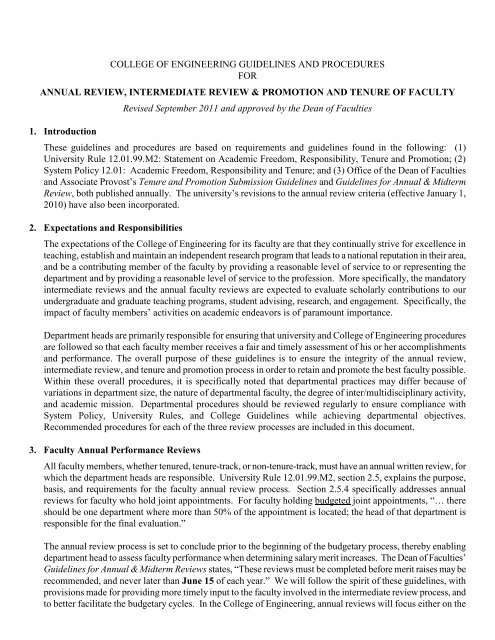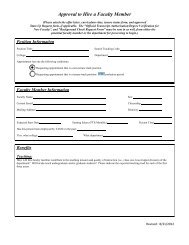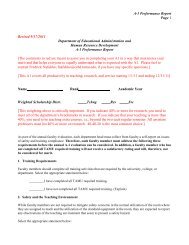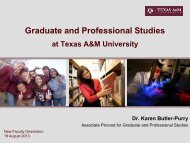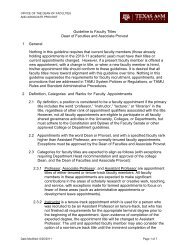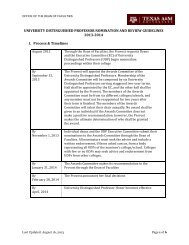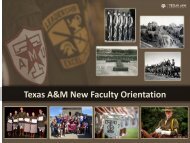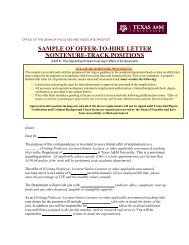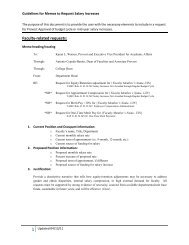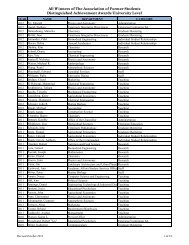Dwight Look College of Engineering - Office of the Dean of Faculties
Dwight Look College of Engineering - Office of the Dean of Faculties
Dwight Look College of Engineering - Office of the Dean of Faculties
You also want an ePaper? Increase the reach of your titles
YUMPU automatically turns print PDFs into web optimized ePapers that Google loves.
COLLEGE OF ENGINEERING GUIDELINES AND PROCEDURES<br />
FOR<br />
ANNUAL REVIEW, INTERMEDIATE REVIEW & PROMOTION AND TENURE OF FACULTY<br />
1. Introduction<br />
Revised September 2011 and approved by <strong>the</strong> <strong>Dean</strong> <strong>of</strong> <strong>Faculties</strong><br />
These guidelines and procedures are based on requirements and guidelines found in <strong>the</strong> following: (1)<br />
University Rule 12.01.99.M2: Statement on Academic Freedom, Responsibility, Tenure and Promotion; (2)<br />
System Policy 12.01: Academic Freedom, Responsibility and Tenure; and (3) <strong>Office</strong> <strong>of</strong> <strong>the</strong> <strong>Dean</strong> <strong>of</strong> <strong>Faculties</strong><br />
and Associate Provost’s Tenure and Promotion Submission Guidelines and Guidelines for Annual & Midterm<br />
Review, both published annually. The university’s revisions to <strong>the</strong> annual review criteria (effective January 1,<br />
2010) have also been incorporated.<br />
2. Expectations and Responsibilities<br />
The expectations <strong>of</strong> <strong>the</strong> <strong>College</strong> <strong>of</strong> <strong>Engineering</strong> for its faculty are that <strong>the</strong>y continually strive for excellence in<br />
teaching, establish and maintain an independent research program that leads to a national reputation in <strong>the</strong>ir area,<br />
and be a contributing member <strong>of</strong> <strong>the</strong> faculty by providing a reasonable level <strong>of</strong> service to or representing <strong>the</strong><br />
department and by providing a reasonable level <strong>of</strong> service to <strong>the</strong> pr<strong>of</strong>ession. More specifically, <strong>the</strong> mandatory<br />
intermediate reviews and <strong>the</strong> annual faculty reviews are expected to evaluate scholarly contributions to our<br />
undergraduate and graduate teaching programs, student advising, research, and engagement. Specifically, <strong>the</strong><br />
impact <strong>of</strong> faculty members’ activities on academic endeavors is <strong>of</strong> paramount importance.<br />
Department heads are primarily responsible for ensuring that university and <strong>College</strong> <strong>of</strong> <strong>Engineering</strong> procedures<br />
are followed so that each faculty member receives a fair and timely assessment <strong>of</strong> his or her accomplishments<br />
and performance. The overall purpose <strong>of</strong> <strong>the</strong>se guidelines is to ensure <strong>the</strong> integrity <strong>of</strong> <strong>the</strong> annual review,<br />
intermediate review, and tenure and promotion process in order to retain and promote <strong>the</strong> best faculty possible.<br />
Within <strong>the</strong>se overall procedures, it is specifically noted that departmental practices may differ because <strong>of</strong><br />
variations in department size, <strong>the</strong> nature <strong>of</strong> departmental faculty, <strong>the</strong> degree <strong>of</strong> inter/multidisciplinary activity,<br />
and academic mission. Departmental procedures should be reviewed regularly to ensure compliance with<br />
System Policy, University Rules, and <strong>College</strong> Guidelines while achieving departmental objectives.<br />
Recommended procedures for each <strong>of</strong> <strong>the</strong> three review processes are included in this document.<br />
3. Faculty Annual Performance Reviews<br />
All faculty members, whe<strong>the</strong>r tenured, tenure-track, or non-tenure-track, must have an annual written review, for<br />
which <strong>the</strong> department heads are responsible. University Rule 12.01.99.M2, section 2.5, explains <strong>the</strong> purpose,<br />
basis, and requirements for <strong>the</strong> faculty annual review process. Section 2.5.4 specifically addresses annual<br />
reviews for faculty who hold joint appointments. For faculty holding budgeted joint appointments, “… <strong>the</strong>re<br />
should be one department where more than 50% <strong>of</strong> <strong>the</strong> appointment is located; <strong>the</strong> head <strong>of</strong> that department is<br />
responsible for <strong>the</strong> final evaluation.”<br />
The annual review process is set to conclude prior to <strong>the</strong> beginning <strong>of</strong> <strong>the</strong> budgetary process, <strong>the</strong>reby enabling<br />
department head to assess faculty performance when determining salary merit increases. The <strong>Dean</strong> <strong>of</strong> <strong>Faculties</strong>’<br />
Guidelines for Annual & Midterm Reviews states, “These reviews must be completed before merit raises may be<br />
recommended, and never later than June 15 <strong>of</strong> each year.” We will follow <strong>the</strong> spirit <strong>of</strong> <strong>the</strong>se guidelines, with<br />
provisions made for providing more timely input to <strong>the</strong> faculty involved in <strong>the</strong> intermediate review process, and<br />
to better facilitate <strong>the</strong> budgetary cycles. In <strong>the</strong> <strong>College</strong> <strong>of</strong> <strong>Engineering</strong>, annual reviews will focus ei<strong>the</strong>r on <strong>the</strong>
Page 2<br />
Annual Review, Intermediate Review & Promotion and Tenure <strong>of</strong> Faculty<br />
immediately previous academic year or <strong>the</strong> previous calendar year, at <strong>the</strong> discretion <strong>of</strong> <strong>the</strong> department head.<br />
3.1 Required Documentation<br />
In December <strong>of</strong> each year, department heads should request that all faculty submit a Faculty Progress Report<br />
and Tenure/Promotion Information (FPR) form (attachment A).<br />
3.2 Process<br />
During January through March, FPRs are reviewed by <strong>the</strong> department head, and a departmental/divisional<br />
committee as appropriate. The department head meets with individual faculty to discuss <strong>the</strong>ir progress,<br />
provide and receive verbal feedback. O<strong>the</strong>r individuals, such as a division head or associate/assistant<br />
department head, or tenure and promotion committee chair may also be included in <strong>the</strong> meeting with<br />
individual faculty members at <strong>the</strong> discretion <strong>of</strong> <strong>the</strong> department head. The discussion should specifically<br />
address <strong>the</strong> following areas: (1) teaching and student advising; (2) research and scholarly publications; (3)<br />
service; (4) safety and safety compliance; (5) plans for <strong>the</strong> coming year; and (6) <strong>the</strong> department head’s<br />
summary and recommendations. In evaluating teaching, research, and service, contributions made to<br />
supporting interdisciplinary and multidisciplinary programs and contributions made to enhancing diversity<br />
and internationalization climate and experiences should be recognized.<br />
After meeting with <strong>the</strong> faculty member, a written evaluation <strong>of</strong> <strong>the</strong> faculty member’s progress/performance is<br />
prepared by <strong>the</strong> department head encompassing <strong>the</strong> areas listed above (sample is available from <strong>the</strong> college<br />
manager <strong>of</strong> faculty services). No faculty member may receive an overall satisfactory rating if <strong>the</strong>y have not<br />
complied with all mandatory university training programs. In cases where a faculty member has been<br />
notified <strong>of</strong> a mandatory training requirement near <strong>the</strong> time <strong>of</strong> <strong>the</strong> end <strong>of</strong> <strong>the</strong> evaluation period, <strong>the</strong>y shall be<br />
given 30 days to complete <strong>the</strong> requirement. Likewise, <strong>the</strong> faculty member must certify <strong>the</strong>ir attentiveness to<br />
safety and compliance. To satisfy <strong>the</strong>se requirements <strong>the</strong> following acknowledgements must be added to <strong>the</strong><br />
“ACKNOWLEDGEMENT” portion <strong>of</strong> <strong>the</strong> department head’s written evaluation and <strong>the</strong> faculty member<br />
must initial each:<br />
<br />
<br />
I acknowledge that I have completed all mandatory university training programs.<br />
I will, on a continuing and timely basis, address any safety deficiencies, report any and all safety<br />
concerns to <strong>the</strong> department head, and demonstrate compliance with safety standards as defined by <strong>the</strong><br />
Environmental Health & Safety Department.<br />
Faculty members are also required to acknowledge receipt <strong>of</strong> <strong>the</strong> written evaluation by returning a signed<br />
copy <strong>of</strong> <strong>the</strong> document to <strong>the</strong> department head. A signed copy is to be placed in <strong>the</strong> faculty member’s<br />
departmental personnel file. At that time, <strong>the</strong> faculty member may add a response to <strong>the</strong> written evaluation<br />
so that it may also be included in <strong>the</strong>ir personnel file. If a faculty member has a complaint concerning <strong>the</strong>ir<br />
written evaluation <strong>the</strong>y may meet with <strong>the</strong> executive associate dean, but only after providing a response and<br />
discussing that response with <strong>the</strong> department head. The department head may be included in <strong>the</strong> meeting<br />
with <strong>the</strong> faculty member, at <strong>the</strong> discretion <strong>of</strong> <strong>the</strong> executive associate dean. As stated in 2.5.3.6 <strong>of</strong> University<br />
Rule 12.01.99.M2: Statement on Academic Freedom, Responsibility, Tenure and Promotion, <strong>the</strong> faculty<br />
member may instead write a letter to <strong>the</strong> dean with a copy to <strong>the</strong> dean <strong>of</strong> faculties.<br />
On or before June 15 <strong>of</strong> each year signed copies <strong>of</strong> reviews for tenure-track faculty should be forwarded to<br />
<strong>the</strong> executive associate dean (EAD). Department heads must also provide a memo which certifies that all<br />
faculty (tenured, tenure-track, non-tenure-track) have been reviewed, have received feedback, and have<br />
signed a copy <strong>of</strong> <strong>the</strong>ir written review. In this memo <strong>the</strong> department heads should specifically indicate any<br />
tenure-track faculty member who is not progressing satisfactorily toward an affirmative tenure decision.
Page 3<br />
Annual Review, Intermediate Review & Promotion and Tenure <strong>of</strong> Faculty<br />
Likewise, an unsatisfactory performance evaluation for a tenured faculty member must also be reported. As<br />
part <strong>of</strong> <strong>the</strong> university’s post-tenure review process, <strong>the</strong> faculty member must <strong>the</strong>n prepare a pr<strong>of</strong>essional<br />
development plan approved by <strong>the</strong> department head and submitted to <strong>the</strong> EAD by <strong>the</strong> June 15 deadline.<br />
Reviews must be completed before merit raises may be recommended, and no later than June 15.<br />
4. Intermediate Review <strong>of</strong> Probationary Faculty Members<br />
The process <strong>of</strong> mid-term reviews was instituted to ensure that tenure-track faculty members have a clear<br />
understanding <strong>of</strong> <strong>the</strong>ir current status and progress toward tenure and promotion. The university requires all<br />
tenure-track faculty members hired with a probationary period <strong>of</strong> 7 years to have an intermediate (or midterm)<br />
review. Intermediate reviews for tenure-track faculty members hired with a probationary period <strong>of</strong> between 4<br />
and 6 years are encouraged but not required by <strong>the</strong> university. Department heads may conduct a slightly more<br />
in-depth “annual review” <strong>of</strong> a faculty member on a less than 7 year probationary period in lieu <strong>of</strong> a formal<br />
intermediate review. The university requires both departmental and college-level tenure and promotion (T&P)<br />
committees review and provide input into <strong>the</strong> formal intermediate review process.<br />
As an additional note, since <strong>the</strong> mandatory intermediate review may take <strong>the</strong> place <strong>of</strong> <strong>the</strong> annual faculty<br />
performance review (at <strong>the</strong> department head’s discretion), all items and acknowledgements mentioned above<br />
must be incorporated into <strong>the</strong> intermediate review unless already stated in a separate annual review.<br />
4.1 Required Documentation<br />
Department heads should meet with intermediate review candidates during December or January to discuss<br />
<strong>the</strong> intermediate review process. The college faculty manager will provide each department with a list <strong>of</strong><br />
mandatory intermediate review candidates. The following items should be requested <strong>of</strong> <strong>the</strong> candidate by a<br />
reasonable deadline to conduct <strong>the</strong> review:<br />
<br />
<br />
<br />
<br />
One to two page statement on <strong>the</strong>ir teaching, research, and service philosophies<br />
Faculty Progress Report and Tenure/Promotion Information Form (FPR)<br />
Up-to-date curriculum vitae (CV) (useful for those with experience elsewhere)<br />
Copies <strong>of</strong> two <strong>of</strong> <strong>the</strong>ir most significant papers published while at TAMU<br />
4.2 Process<br />
During February or March <strong>the</strong> departmental T&P committee reviews each case and provides written<br />
evaluation and recommendations to <strong>the</strong> department head. Departmental recommendations are due to <strong>the</strong><br />
college by <strong>the</strong> second Friday <strong>of</strong> April. At that time <strong>the</strong> department head should submit <strong>the</strong> following items<br />
to <strong>the</strong> executive associate dean (EAD):<br />
One original copy in single-sided, unstapled format (folders are not needed), and one electronic copy, both in<br />
<strong>the</strong> following order:<br />
A DRAFT memo to <strong>the</strong> faculty member from <strong>the</strong> department head (sample memo available from <strong>the</strong><br />
college faculty manager) evaluating teaching/student advising, research/scholarly publications, service,<br />
safety and safety compliance and future plans. This evaluation should specifically identify strengths,<br />
weaknesses, and recommendations for corrective action and preliminary recommendation. In evaluating<br />
teaching, research, and service contributions made to supporting interdisciplinary and multidisciplinary<br />
programs and contributions made to enhancing diversity and internationalization climate and<br />
experiences should be recognized. The required safety and training acknowledgements must be added if<br />
not already verified in a separate annual review. An acknowledgement <strong>of</strong> receipt must be added. In<br />
addition, <strong>the</strong> draft memo should be submitted in MS Word format.
Page 4<br />
Annual Review, Intermediate Review & Promotion and Tenure <strong>of</strong> Faculty<br />
Departmental T&P committee’s written evaluation/recommendation addressing teaching, student<br />
advising, research, scholarship, and service, including any individual reports on teaching, research, and<br />
service. Supporting documents, such as teaching evaluation data, may be added after this item.<br />
Information submitted by <strong>the</strong> faculty candidate (in <strong>the</strong> order stated under 4.1).<br />
During April and May a sub-group <strong>of</strong> <strong>the</strong> <strong>College</strong> <strong>of</strong> <strong>Engineering</strong> Tenure and Promotion Advisory<br />
Committee (CETPAC) reviews each case and provides a written evaluation and recommendation on<br />
each to <strong>the</strong> dean.<br />
In May and/or June <strong>the</strong> dean and/or EAD will meet with department heads to discuss all<br />
recommendations and <strong>the</strong> overall outcome <strong>of</strong> each case. The DRAFT memos to each candidate are<br />
reviewed and revised as necessary to include any suggested corrective actions. Department heads finalize<br />
<strong>the</strong> written evaluation with <strong>the</strong> EAD, meet with individual faculty to discuss <strong>the</strong>ir progress and present<br />
<strong>the</strong> faculty member with <strong>the</strong> formal written review. Faculty members will acknowledge receipt <strong>of</strong> <strong>the</strong>ir<br />
evaluation by signing <strong>the</strong> document. A signed copy is sent to <strong>the</strong> <strong>of</strong>fice <strong>of</strong> <strong>the</strong> EAD, and <strong>the</strong> original<br />
document is retained in <strong>the</strong> faculty member’s personnel file.<br />
5. Tenure & Promotion Reviews<br />
5.1 Criteria and Performance Measures for Appointment and Advancement<br />
Section 4.5.4 <strong>of</strong> <strong>the</strong> University’s Statement on Academic Freedom, Responsibility, Tenure, and Promotion<br />
(University Rule 12.01.99.M2 - Section 4.4) addresses exceptions to <strong>the</strong> normal requirements for tenure and<br />
promotion.<br />
“Exceptions to <strong>the</strong> normal requirements for tenure and promotion may sometimes be<br />
warranted. Examples would include (a) gifted and productive master teachers who are<br />
abreast <strong>of</strong> <strong>the</strong>ir field but who have not contributed extensively to <strong>the</strong> development <strong>of</strong> new<br />
knowledge, (b) exceptionally outstanding researchers whose teaching is merely acceptable,<br />
and (c) tenured faculty whose sustained service to <strong>the</strong> University is unselfish, distinctive and<br />
outstanding, but whose teaching and research are only acceptable. Few faculty will possess<br />
qualities such as <strong>the</strong>se, but those who do deserve recognition and advancement.”<br />
Most faculty should be evaluated for tenure and promotion on accomplishments in each <strong>of</strong> <strong>the</strong> three major<br />
categories <strong>of</strong> performance (teaching and student advising, research, and service/engagement), but with<br />
primary emphasis on teaching and <strong>the</strong> creation and dissemination <strong>of</strong> new knowledge or o<strong>the</strong>r creative<br />
activities, including patents or commercialization <strong>of</strong> research, where applicable. Recent changes made to <strong>the</strong><br />
faculty review criteria mandate awarding appropriate credit to faculty who actively work toward achieving<br />
<strong>the</strong> university’s goals in three major areas: (1) supporting multidisciplinary collaboration; (2) enhancing<br />
diversity and internationalization climate and experiences; and (3) requiring appropriate attention to safety<br />
and compliance.<br />
Imperatives for tenure and promotion in <strong>the</strong> <strong>College</strong> <strong>of</strong> <strong>Engineering</strong> are: effective classroom instruction,<br />
successful advising <strong>of</strong> undergraduate and graduate students, ability to sustain an independent research<br />
program, scholarly contributions, and evidence <strong>of</strong> service.<br />
Although some quantitative measures <strong>of</strong> evaluation may be employed, excellence in performance is <strong>of</strong><br />
primary importance; that is, <strong>the</strong> quality, significance, and impact <strong>of</strong> accomplishments are <strong>of</strong> much greater<br />
importance than <strong>the</strong>ir numbers. For tenure and promotion, in addition to meritorious accomplishments, a<br />
high potential for continued excellence is required.<br />
Please see attachment B for information regarding criteria for tenure and promotion in <strong>the</strong> Department <strong>of</strong>
Page 5<br />
Annual Review, Intermediate Review & Promotion and Tenure <strong>of</strong> Faculty<br />
<strong>Engineering</strong> Technology and Industrial Distribution.<br />
5.2 Outside Pr<strong>of</strong>essional Experience<br />
It is important that engineering faculty be aware <strong>of</strong> <strong>the</strong> current state <strong>of</strong> pr<strong>of</strong>essional practice and research.<br />
Continuing interaction with industry and <strong>the</strong> pr<strong>of</strong>essional research community is essential to a faculty<br />
member’s maintaining pr<strong>of</strong>essional currency. Mechanisms for accomplishing this continuing development<br />
may include: summer/temporary employment or faculty development leaves at o<strong>the</strong>r universities, within<br />
industry or government laboratories, consulting activities, etc.<br />
5.3 Time <strong>of</strong> Service within Rank<br />
There is no firm period <strong>of</strong> service required for advancement in <strong>the</strong> <strong>College</strong> <strong>of</strong> <strong>Engineering</strong>. Ra<strong>the</strong>r,<br />
advancement will be based on accomplishments which merit tenure and/or promotion. Determining <strong>the</strong> year<br />
<strong>of</strong> mandatory consideration for tenure track faculty is calculated as follows:<br />
Calendar year hired + Probationary period – 2 years = Tenure Consideration Year<br />
Normally, one academic year is required for preparation and processing <strong>of</strong> cases for promotion and/or tenure.<br />
Successful recommendations will result in <strong>the</strong> advancement becoming effective at <strong>the</strong> beginning <strong>of</strong> <strong>the</strong><br />
following academic year (i.e., September 1).<br />
5.4 Identifying Candidates for Tenure and/or Promotion Consideration<br />
The department head and/or <strong>the</strong> departmental T&P committee should identify candidates for tenure and/or<br />
promotion by February 15 <strong>of</strong> each calendar year. A memo should be sent to all non-tenured tenure-track<br />
faculty, as well as to all associate pr<strong>of</strong>essors (tenured and non-tenured) to 1) inform <strong>the</strong>m that <strong>the</strong>y are up for<br />
mandatory tenure and/or promotion, or 2) ask <strong>the</strong>m if <strong>the</strong>y would like to be considered for tenure and/or<br />
promotion. A reasonable deadline should be established so that <strong>the</strong> department head can begin <strong>the</strong> process.<br />
Once candidates are identified, <strong>the</strong>y should receive a copy <strong>of</strong> <strong>the</strong> current tenure and promotion procedures<br />
and guidelines <strong>of</strong> <strong>the</strong> university (available from <strong>the</strong> <strong>Dean</strong> <strong>of</strong> <strong>Faculties</strong> website), <strong>the</strong> college and <strong>the</strong><br />
department (if separate from <strong>the</strong> college).<br />
5.5 Required Documentation<br />
Department heads should meet individually with candidates to discuss <strong>the</strong> process. They should be<br />
instructed (in writing) to prepare and submit <strong>the</strong> following items to <strong>the</strong> department head or a designate<br />
(typically a staff coordinator for <strong>the</strong> process) by a reasonable deadline that will allow time for selection <strong>of</strong><br />
<strong>the</strong> external reviewers and solicitation <strong>of</strong> letters by March 31, and no later than May 31:<br />
<br />
<br />
<br />
<br />
<br />
<br />
A concise statement (three pages, single spaced, maximum) on goals, philosophies, strategies and<br />
emphasis on carrying out pr<strong>of</strong>essional responsibilities in teaching, research and service/engagement.<br />
Up-to-date curriculum vitae (CV) with a signed statement that <strong>the</strong> CV being submitted is current and<br />
correct as <strong>of</strong> <strong>the</strong> date <strong>of</strong> signature.<br />
A list <strong>of</strong> between 6 and 8 names <strong>of</strong> potential external reviewers, toge<strong>the</strong>r with a short biography <strong>of</strong> each.<br />
According to university guidelines, <strong>the</strong> reviewers should be from peer institutions/programs or better.<br />
The candidate should also be asked to provide a list <strong>of</strong> individuals that <strong>the</strong>y do not want contacted to be<br />
an external reviewer.<br />
A list <strong>of</strong> up to three potential reviewers from within <strong>the</strong> Texas A&M community who can address<br />
inter/multidisciplinary and/or internationalization activities, as applicable (optional).<br />
The <strong>College</strong>’s Faculty Progress Report and Tenure/Promotion Information Form (FPR).<br />
Copies <strong>of</strong> selected refereed publications (<strong>the</strong>ir most significant papers published while at TAMU) to be<br />
forwarded to external reviewers. Departments may set limits on <strong>the</strong> number <strong>of</strong> publications to be
Page 6<br />
Annual Review, Intermediate Review & Promotion and Tenure <strong>of</strong> Faculty<br />
<br />
submitted.<br />
O<strong>the</strong>r materials as may be requested by departmental T&P committees or <strong>the</strong> department head (i.e., a<br />
teaching portfolio, etc.)<br />
The department head should make it clear to <strong>the</strong> candidate that <strong>the</strong>se materials may be updated at any stage<br />
<strong>of</strong> <strong>the</strong> process, and that updates should be signed and dated by <strong>the</strong> candidate.<br />
5.6 Solicitation <strong>of</strong> External Reviewers<br />
University guidelines on <strong>the</strong> method <strong>of</strong> selection <strong>of</strong> reviewers must be followed: at least one from <strong>the</strong><br />
candidate’s list; at least one from <strong>the</strong> department head’s or departmental T&P committee’s list; and no one<br />
designated by <strong>the</strong> candidate as not to be contacted. In addition, efforts should be made to avoid individuals<br />
with whom <strong>the</strong> candidate has had an unusually close working relationship, such as <strong>the</strong> candidate’s faculty<br />
advisor. Letters from former students are irrelevant except as supportive documents for <strong>the</strong> teaching<br />
evaluation.<br />
To better facilitate <strong>the</strong> solicitation <strong>of</strong> input from external reviewers for tenure and promotion cases, <strong>the</strong><br />
process should take place mid-spring. Department heads are required to review all potential external<br />
reviewers to ensure <strong>the</strong>y are from recognized peer institutions/programs or better and are clear leaders in <strong>the</strong><br />
field. The departmental T&P committee may provide input. Contact with <strong>the</strong>se individuals requesting <strong>the</strong>ir<br />
service as a reviewer must be in <strong>the</strong> form <strong>of</strong> a personal letter from <strong>the</strong> department head. This letter, along<br />
with selected materials for review, should be sent to external reviewers by March 31, and no later than May<br />
31. The college expects a minimum <strong>of</strong> six letters with balance among letters from reviewers from <strong>the</strong><br />
candidate’s and departmental lists. Departments should request no more than 8 letters in <strong>the</strong> initial<br />
solicitation, ideally 4 from <strong>the</strong> candidate’s selections and 4 from <strong>the</strong> departmental selections. The<br />
solicitation letter must contain <strong>the</strong> following statement:<br />
Your letter will be kept confidential to <strong>the</strong> extent allowed by Texas law. However, under Texas<br />
law, <strong>the</strong> person made <strong>the</strong> subject <strong>of</strong> your letter may obtain a copy <strong>of</strong> <strong>the</strong> document upon request.<br />
If a solicitation letter is sent containing a request for specific examples <strong>of</strong> <strong>the</strong> candidate’s current and<br />
potential scholarship and/or impact <strong>of</strong> teaching and service and <strong>the</strong> required statement above, and <strong>the</strong> referee<br />
declines to write a letter for <strong>the</strong> candidate, that reviewer must still be listed in <strong>the</strong> dossier reviewer chart,<br />
indicating that <strong>the</strong>y declined.<br />
At no time is <strong>the</strong> candidate to inquire about <strong>the</strong> status <strong>of</strong> <strong>the</strong> reviewers he/she nominates, or to contact <strong>the</strong>m.<br />
5.7 Process<br />
Once <strong>the</strong> necessary number <strong>of</strong> external review letters has been received, <strong>the</strong>y, along with <strong>the</strong> o<strong>the</strong>r items<br />
submitted by <strong>the</strong> candidate, should be made available to <strong>the</strong> departmental tenure and promotion committee<br />
(see section 7) for review. The candidate’s items may be given to <strong>the</strong> committee prior to receipt <strong>of</strong> <strong>the</strong><br />
external letters at <strong>the</strong> discretion <strong>of</strong> <strong>the</strong> department head. In ei<strong>the</strong>r case, confidentiality <strong>of</strong> hard copy and<br />
electronic files should be maintained throughout <strong>the</strong> process. Signed and dated updates by <strong>the</strong> candidate<br />
should be distributed immediately to <strong>the</strong> committee members and department head, and incorporated into <strong>the</strong><br />
candidate’s original copy items.<br />
The departmental tenure and promotion committee meets to discuss and vote on each candidate, as described<br />
in section 7.2. This committee also produces teaching, research and service peer evaluations as required for<br />
<strong>the</strong> dossier.
Page 7<br />
Annual Review, Intermediate Review & Promotion and Tenure <strong>of</strong> Faculty<br />
The department head prepares a separate recommendation evaluating <strong>the</strong> candidate’s teaching, research, and<br />
service. This document must:<br />
<br />
<br />
<br />
<br />
<br />
<br />
Provide a general basis for strength and weakness <strong>of</strong> <strong>the</strong> case<br />
Provide an explanation <strong>of</strong> <strong>the</strong> candidate’s impact on academic endeavors<br />
Provide <strong>the</strong> context <strong>of</strong> this particular case within <strong>the</strong> department<br />
Explain special considerations (i.e., early promotion/tenure, delays in promotion/tenure, special hiring<br />
circumstances)<br />
Explain any mixed or negative votes if not explained in <strong>the</strong> committee’s report<br />
Explain <strong>the</strong> department head’s vote, especially if contrary to <strong>the</strong> departmental committee’s<br />
recommendation.<br />
O<strong>the</strong>r considerations itemized in section 7.3 should also be addressed. The departmental tenure and<br />
promotion (T&P) coordinator <strong>the</strong>n structures all documents into <strong>the</strong> dossier for submission to <strong>the</strong> dean.<br />
The department head is responsible for notifying each candidate <strong>of</strong> <strong>the</strong> outcome at every level, including <strong>the</strong><br />
departmental committee’s vote, <strong>the</strong> department head’s vote, <strong>the</strong> dean’s vote, <strong>the</strong> university’s decision, and<br />
ultimately <strong>the</strong> Board <strong>of</strong> Regents decision. The dean will notify <strong>the</strong> department heads <strong>of</strong> decisions at <strong>the</strong><br />
college, university and system level so that <strong>the</strong>y can relay that information to <strong>the</strong> candidate.<br />
6. <strong>College</strong> Tenure & Promotion Committee<br />
6.1 Selection and Structure<br />
University Rule 12.01.99.M2, section 4.6.3 states, “In conducting tenure and/or promotion reviews, <strong>the</strong> dean<br />
shall draw upon <strong>the</strong> advice and counsel <strong>of</strong> a college-wide tenure and promotion committee.” The <strong>College</strong> <strong>of</strong><br />
<strong>Engineering</strong> Tenure and Promotion Advisory Committee (CETPAC) is comprised <strong>of</strong> one member from each<br />
academic department, as well as any appointment made by <strong>the</strong> dean to ensure diversity. The college’s<br />
executive associate dean serves as ex <strong>of</strong>ficio chair <strong>of</strong> this committee, and does not vote in this venue.<br />
Department heads nominate two members <strong>of</strong> <strong>the</strong> departmental review committee and <strong>the</strong> dean makes <strong>the</strong><br />
final decision regarding appointment to CETPAC. Members serve a two-year term, with half <strong>of</strong> <strong>the</strong><br />
representatives being held over for <strong>the</strong> next year’s committee and half rotating <strong>of</strong>f <strong>the</strong> committee. Members<br />
are not allowed to vote on cases from <strong>the</strong>ir home department. Committee deliberations and final votes are<br />
presented to <strong>the</strong> dean. The dean may also seek input from <strong>the</strong> college’s associate and/or assistant deans, but<br />
it is <strong>the</strong> dean with whom <strong>the</strong> final decision rests.<br />
6.2 <strong>College</strong> Committee’s Report and Recommendation<br />
The college committee’s report and recommendation should be similar to <strong>the</strong> departmental T&P committee<br />
report, reflecting <strong>the</strong> ultimate vote <strong>of</strong> <strong>the</strong> committee and <strong>the</strong> primary issues that convinced members to vote<br />
one way or <strong>the</strong> o<strong>the</strong>r.<br />
7. Department Tenure & Promotion Committee<br />
7.1 Selection and Structure<br />
Departmental T&P committees shall consist <strong>of</strong> 5-9 members who, except as noted below, are tenured full<br />
pr<strong>of</strong>essors in <strong>the</strong> department. This committee shall be constituted as follows: at least half or a majority <strong>of</strong><br />
<strong>the</strong> committee shall consist <strong>of</strong> members elected by <strong>the</strong> departmental faculty. To provide area balance or<br />
interdisciplinary representation, <strong>the</strong> department head may appoint not more than two full pr<strong>of</strong>essors from<br />
outside <strong>the</strong> department, or tenured associate pr<strong>of</strong>essors from within <strong>the</strong> department. If associate pr<strong>of</strong>essors<br />
are appointed, <strong>the</strong>y must recuse <strong>the</strong>mselves from any deliberations or votes concerning <strong>the</strong> promotion <strong>of</strong>
Page 8<br />
Annual Review, Intermediate Review & Promotion and Tenure <strong>of</strong> Faculty<br />
faculty to full pr<strong>of</strong>essor. If associate pr<strong>of</strong>essors are appointed, care should be taken so that <strong>the</strong> size <strong>of</strong> <strong>the</strong><br />
committee is sufficient to ensure proper evaluation <strong>of</strong> candidates for full pr<strong>of</strong>essor once associate pr<strong>of</strong>essors<br />
have been excused. The members <strong>of</strong> <strong>the</strong> committee should be appointed or elected to staggered terms to<br />
ensure that not more than one-half <strong>of</strong> <strong>the</strong> committee rotates <strong>of</strong>f on an annual basis. Two year staggered<br />
terms are recommended. The chair <strong>of</strong> <strong>the</strong> committee shall be appointed by <strong>the</strong> department head.<br />
As an alternative to <strong>the</strong> above procedure, <strong>the</strong> committee may be constituted as all tenured full pr<strong>of</strong>essors in a<br />
department (preferably maintaining <strong>the</strong> five member minimum). Departments may elect to include all<br />
tenured associate pr<strong>of</strong>essors in <strong>the</strong> committee provided that <strong>the</strong>y are required to recuse <strong>the</strong>mselves from any<br />
deliberations or votes concerning <strong>the</strong> promotion <strong>of</strong> faculty to full pr<strong>of</strong>essor. In this case, an election need not<br />
be held. The committee may be augmented as described above.<br />
7.2 Operation <strong>of</strong> <strong>the</strong> Departmental Tenure & Promotion Committee<br />
The departmental T&P committee shall review every tenure-track faculty member for <strong>the</strong>ir intermediate and<br />
mandatory tenure reviews. Additional reviews may be done at <strong>the</strong> request <strong>of</strong> ei<strong>the</strong>r <strong>the</strong> candidate or <strong>the</strong><br />
department head. Tenured associate pr<strong>of</strong>essors shall be reviewed by <strong>the</strong> committee for promotion upon<br />
request by ei<strong>the</strong>r <strong>the</strong> candidate or <strong>the</strong> department head. Prospective faculty members whose recommended<br />
appointment is with tenure must also be reviewed by this committee. If, as a result <strong>of</strong> an annual performance<br />
review, a tenure-track faculty member is recommended by <strong>the</strong> department head for non-reappointment prior<br />
to <strong>the</strong>ir mandatory tenure review, he or she must be reviewed by <strong>the</strong> committee and <strong>the</strong> results <strong>of</strong> this review<br />
must be submitted through <strong>the</strong> department head to <strong>the</strong> dean with <strong>the</strong> recommendation for non-reappointment.<br />
For <strong>the</strong> tenure and promotion process, <strong>the</strong> departmental committee is charged with:<br />
<br />
<br />
<br />
Review and evaluation <strong>of</strong> <strong>the</strong> candidate’s dossier<br />
Producing separate written peer reviews on each candidate’s teaching, research and service (authorship<br />
<strong>of</strong> <strong>the</strong>se documents should be clearly delineated)<br />
Producing a complete report and recommendation explaining <strong>the</strong> committee’s vote and reasoning for<br />
<strong>the</strong>ir recommendation, and, if applicable, an overview <strong>of</strong> <strong>the</strong> candidate’s progress and impact as it relates<br />
to <strong>the</strong>ir suitability for eventual promotion and/or tenure (see item 7.3) (to be signed by all committee<br />
members).<br />
The committee may seek input from o<strong>the</strong>r sources, including division heads or o<strong>the</strong>r faculty. However, <strong>the</strong>se<br />
individuals shall not be present during <strong>the</strong> committee's final deliberations, nor shall <strong>the</strong>y be present during<br />
voting. Since <strong>the</strong> committee is viewed as advisory to both <strong>the</strong> department head and <strong>the</strong> dean, its vote should<br />
be independent <strong>of</strong> any action by <strong>the</strong> department head. Hence, <strong>the</strong> department head should not be present<br />
during committee discussions or voting.<br />
A secret ballot should be used to record <strong>the</strong> committee's vote that will be reported by <strong>the</strong> committee chair to<br />
<strong>the</strong> department head, who will forward it to <strong>the</strong> dean. At least two committee members should count <strong>the</strong><br />
votes and <strong>the</strong> results should be announced to <strong>the</strong> committee immediately. All committee members must be<br />
present and absentee ballots should not be used, unless an explicit waiver is received from <strong>the</strong> department<br />
head or his/her designee. A written proxy may be allowed in emergency situations. Committee members<br />
should not abstain from voting, except in unusual circumstances such as conflict <strong>of</strong> interest, etc. In <strong>the</strong>se<br />
cases, <strong>the</strong> committee member should recuse him/herself from <strong>the</strong> discussion <strong>of</strong> <strong>the</strong> candidate as well as <strong>the</strong><br />
voting.
Page 9<br />
Annual Review, Intermediate Review & Promotion and Tenure <strong>of</strong> Faculty<br />
7.3 Departmental Tenure & Promotion Committee Report<br />
The departmental T&P Committee report should address <strong>the</strong> areas <strong>of</strong> teaching, research, and<br />
service/engagement. The report should also include information regarding <strong>the</strong> faculty member’s<br />
contributions to multidisciplinary collaborations, technology commercialization and enhancing diversity and<br />
internationalization climate and experiences (at <strong>the</strong> university and/or college levels). The committee must<br />
summarize its conclusions concerning each candidate with sufficient information for <strong>the</strong> department head,<br />
dean, and upper administration to understand <strong>the</strong> reasoning behind <strong>the</strong>ir recorded vote. A mixed vote would<br />
require fur<strong>the</strong>r explanation <strong>of</strong> both <strong>the</strong> candidate’s demonstrated abilities, and <strong>the</strong> committee’s concerns.<br />
O<strong>the</strong>r considerations for <strong>the</strong> departmental committee report are:<br />
<br />
<br />
<br />
<br />
Authorship <strong>of</strong> <strong>the</strong> final report is to be made clear and <strong>the</strong> report is to be signed by all committee<br />
members.<br />
o University guidelines recommend that a statement such as, “The opinions and conclusions stated in<br />
this report regarding <strong>the</strong> candidate accurately reflect <strong>the</strong> views <strong>of</strong> <strong>the</strong> T&P committee,” appear at <strong>the</strong><br />
end <strong>of</strong> each report.<br />
Authorship protocol must be addressed by <strong>the</strong> departmental committee or by <strong>the</strong> department head,<br />
especially relating to ordering <strong>of</strong> authors and how team members must contribute in order to be listed as<br />
a coauthor.<br />
Quality and impact. Departmental committees and department heads should be mindful <strong>of</strong> <strong>the</strong> multiple<br />
audiences who review <strong>the</strong> T&P files and need to address “quality and impact” factors within <strong>the</strong>ir<br />
specific discipline. Assume <strong>the</strong> audience is unfamiliar with <strong>the</strong> field. Some example areas: <strong>the</strong><br />
importance <strong>of</strong> an award or citation; service and/or election to a pr<strong>of</strong>essional organization; why published<br />
conference papers may be more significant than journal publications.<br />
Acronyms should be defined at first use, i.e., American Society <strong>of</strong> Mechanical Engineers (ASME).<br />
Again, assume <strong>the</strong> audience is unfamiliar with <strong>the</strong> field.
FACULTY PROGRESS REPORT<br />
AND<br />
TENURE/PROMOTION INFORMATION FORM<br />
Attachment A<br />
Name Dept. Mo/Yr<br />
Academic Degrees (list all):<br />
Degree Field Institution Year<br />
States in which registered as an engineer (list all):<br />
State License Number Date Granted<br />
Date and type <strong>of</strong> most recent TAMU personnel action (hiring or tenure and/or promotion):<br />
Action<br />
Month/Year<br />
PROVIDE INFORMATION ONLY SINCE YOUR LAST HIRING ACTION UNLESS OTHERWISE<br />
NOTED<br />
I. TEACHING<br />
1. Teaching effectiveness - list or describe any comments or measures <strong>of</strong> teaching effectiveness used and<br />
results obtained. (No more than a one page summary <strong>of</strong> student comments should be included - do not<br />
include student evaluation forms.)<br />
2. Educational development - describe <strong>the</strong> development <strong>of</strong> any new courses or major changes or<br />
innovations in existing programs or courses, new curricula, new laboratories, and teaching methods,<br />
including <strong>the</strong> application <strong>of</strong> new technology (e.g. educational s<strong>of</strong>tware development), but not <strong>the</strong><br />
normal updating and revision <strong>of</strong> courses.<br />
3. Publication <strong>of</strong> textbooks and <strong>of</strong> education papers (including papers on educational s<strong>of</strong>tware<br />
developed) in recognized journals: (Use proper bibliographic format - authors must be in <strong>the</strong> proper<br />
order.)<br />
A. O<strong>the</strong>r institutions using educational materials developed:<br />
4. Courses taught - please indicate information requested below for each course taught, beginning with<br />
<strong>the</strong> most recent (since last hiring action). Insert or delete rows as necessary.
Attachment A<br />
Page 2<br />
A. Undergraduate and graduate courses (list graduate research courses in I.4.B); sample information is<br />
highlighted. Your department will provide <strong>the</strong> average numerical grade for equivalent level<br />
courses.<br />
Course<br />
Semester<br />
Number <strong>of</strong><br />
Students<br />
Mean Student<br />
Evaluation<br />
Score<br />
Avg Numerical<br />
Grade Earned by<br />
Students<br />
Dept Avg Numerical<br />
Grade for<br />
Equivalent Level<br />
Courses<br />
ENGR 482 FA09 21 3.25 3.0 3.2<br />
SP09<br />
SU09<br />
Total number <strong>of</strong> students taught:<br />
B. Graduate research courses; sample information is highlighted (insert or delete rows as necessary).<br />
Course Semester<br />
Last Name <strong>of</strong><br />
Student<br />
Credit<br />
Hours<br />
ENGR 691 FA09 Jones 3<br />
SP09<br />
SU09<br />
Brief analysis <strong>of</strong> <strong>the</strong> data in I.4.A and/or I.4.B (optional):
Attachment A<br />
Page 3<br />
5. Student research advising – list student name, <strong>the</strong> degree, <strong>the</strong>sis title, and estimated or actual<br />
graduation date. Principal advising is assumed; if co-chair, please indicate.<br />
PROVIDE CUMULATIVE INFORMATION FOR THIS ITEM<br />
A. Masters<br />
B. Doctorate<br />
6. Teaching improvement – list specific programs or short courses participated in to improve teaching<br />
competence.<br />
II. RESEARCH AND/OR DESIGN<br />
PROVIDE CUMULATIVE INFORMATION FOR ITEMS 1., 2., 3. AND 4. OF THIS<br />
SECTION. PLEASE DELINEATE YOUR CONTRIBUTIONS SINCE JOINING TEXAS<br />
A&M UNIVERSITY.<br />
1. Refereed journal publications – begin with most recent publications first and use proper bibliographic<br />
format; authors must be in <strong>the</strong> proper order. For accepted but unpublished articles, provide appropriate<br />
correspondence.<br />
DESIGNATE PUBLICATIONS WITH STUDENTS (PAST OR PRESENT) WITH AN<br />
ASTERISK (*)<br />
A. Published or accepted journal publications:<br />
B. Journal papers submitted:<br />
2. Publication <strong>of</strong> books or authoritative references – list in following format:<br />
[Author's last name and initials, co-authors, title, publisher, publisher location, year.]<br />
3. O<strong>the</strong>r publications – begin with most recent publications first and use proper bibliographic format.<br />
Acceptance rates may be included to confirm peer review and status <strong>of</strong> conference venue. Include<br />
research reports for sponsors.<br />
A. Published or accepted conference papers:<br />
B. O<strong>the</strong>r (please specify):<br />
4. Funded research projects - list in following format:<br />
[Title, sponsor, principal investigator, co-principal investigator/s, number <strong>of</strong> graduate students<br />
supported, inclusive dates, dollar value total AND pro-rated amount for <strong>the</strong> individual faculty<br />
member.]<br />
A. Externally funded research projects:
Attachment A<br />
Page 4<br />
B. Internally funded research projects:<br />
5. Research proposals - list in following format:<br />
[Title, sponsor, principal investigator, co-principal investigator/s, date submitted, dollar value, status];<br />
indicate whe<strong>the</strong>r proposal is competitive and subject to peer review.<br />
6. New design methods, techniques or concepts developed – design <strong>of</strong> generic new operating devices and<br />
systems, including patents and s<strong>of</strong>tware systems in use in industry or elsewhere.<br />
III. SERVICE<br />
1. Pr<strong>of</strong>essional service – list state, national, and international service only. (These activities must be<br />
related to <strong>the</strong> area <strong>of</strong> pr<strong>of</strong>essional expertise and must not earn financial remuneration o<strong>the</strong>r than an<br />
honorarium.) List in <strong>the</strong> following format:<br />
[Organization, your responsibility or title, indication whe<strong>the</strong>r responsibility is an elected or appointed<br />
<strong>of</strong>fice, geographical scope and inclusive dates.]<br />
2. University and community service – please limit to major assignments and use format as above. (Note<br />
that multidisciplinary service is to be reported in item IV.3.)<br />
IV. MULTIDISCIPLINARY STRATEGIC AREAS AT THE UNIVERSITY LEVEL<br />
1. Creation <strong>of</strong> knowledge or creative activities – list activities related to university landmark areas <strong>of</strong><br />
research, university recognized centers or institutes, participation in significant multidisciplinary<br />
projects and active participation in said projects awarded for $1.5M or more:<br />
2. Teaching – list teaching activities related to interdisciplinary program courses, service learning oriented<br />
experiences for students, entrepreneurship classes or activities and disciplinary courses in a learning<br />
community that involves students that span two or more colleges:<br />
3. Service/engagement – list participation in major assignments at <strong>the</strong> university level such as Faculty<br />
Senate, a university council or committee, CPI leadership, any recognized faculty network, search<br />
committee for a dean or university-level administrator, K-12 outreach, community or corporate<br />
partnerships or projects, including funded research, training programs and coursework development:<br />
V. INTERNATIONALIZATION<br />
1. Engagement with <strong>the</strong> international community <strong>of</strong> scholars in <strong>the</strong> field – continued and enhanced<br />
leadership at <strong>the</strong> international level in <strong>the</strong> field is encouraged and valued. List activities related to<br />
leadership, development and involvement in study abroad and international activities (list international<br />
lectures or seminars in V.2):
Attachment A<br />
Page 5<br />
2. International invited significant lectures or seminars – list in <strong>the</strong> following format:<br />
[Name, title, group addressed, institution, location, date.]<br />
VI. DIVERSITY<br />
1. Engagement in diversity initiatives – as with internationalization, continued and enhanced leadership in<br />
diversity initiatives is encouraged and valued. List activities that focus on enhancing students’<br />
knowledge <strong>of</strong> disparities and differences experienced by diverse groups and skills in working among<br />
diverse cultures. Examples may be engagement in funded projects, recruitment and retention,<br />
workshops, seminars or courses presented or taken, and participation in publication projects or creative<br />
activities that enhance understanding <strong>of</strong> diversity issues in higher education or disciplinary fields:<br />
VII. PROFESSIONAL OUTREACH<br />
1. Continuing education/pr<strong>of</strong>essional development - list programs or short courses, dates taught, number<br />
<strong>of</strong> students, and number <strong>of</strong> times taught previously:<br />
2. National invited significant seminars or lectures – list in <strong>the</strong> following format:<br />
[Name, title, group addressed, institution, location, date.]<br />
3. Review <strong>of</strong> journal papers and/or research proposals (i.e., where faculty member served as <strong>the</strong> peer<br />
reviewer and inclusive dates):<br />
4. Consulting – consulting activities or o<strong>the</strong>r pr<strong>of</strong>essional work <strong>of</strong> unique character which have potential<br />
valuable carry over into <strong>the</strong> educational process. Include dates and companies:<br />
5. O<strong>the</strong>r pr<strong>of</strong>essional outreach:<br />
VIII. HONORS AND AWARDS<br />
1. Honor and/or award – list organization, citation, date and where awarded if appropriate.<br />
IX. SAFETY<br />
1. Safety in <strong>the</strong> teaching and research environment – faculty members are responsible for reasonable<br />
mitigation <strong>of</strong> safety concerns in <strong>the</strong> environments <strong>the</strong>y have been assigned as <strong>the</strong> lead researcher or<br />
instructor <strong>of</strong> record. Please report any observations <strong>of</strong> <strong>the</strong> teaching or research environment that seem<br />
to present a safety hazard.
Attachment A<br />
Page 6<br />
X. IMPACT (COMPLETE THIS SECTION ONLY IF YOU ARE BEING CONSIDERED FOR<br />
TENURE AND/OR PROMOTION REVIEW)<br />
1. Please state <strong>the</strong> overall impact <strong>of</strong> your academic contributions and activities; limit to one half page.<br />
XI. PLANS FOR THE COMING YEAR<br />
1. Pr<strong>of</strong>essional development plans - please list your proposed scholarly and pr<strong>of</strong>essional activities for <strong>the</strong><br />
coming year along with a proposed division <strong>of</strong> effort:<br />
XII. OTHER ITEMS<br />
O<strong>the</strong>r items which <strong>the</strong> faculty member believes are important and have reported to <strong>the</strong> department head.<br />
The attractiveness <strong>of</strong> higher education has always been <strong>the</strong> excitement <strong>of</strong> belonging to a scholarly<br />
community. A faculty member is free to pursue various activities, some <strong>of</strong> which may be valuable but are<br />
not usually recognized for promotion or tenure. Yet, a faculty member may wish to report <strong>the</strong>se items or<br />
call <strong>the</strong> department head's attention to o<strong>the</strong>r items which may fit in with <strong>the</strong> goals <strong>of</strong> <strong>the</strong> department, <strong>the</strong><br />
college, and <strong>the</strong> university. Please itemize.
Attachment B<br />
APPOINTMENT, PROMOTION AND TENURE OF FACULTY<br />
IN THE DEPARTMENT OF ENGINEERING TECHNOLOGY &<br />
INDUSTRIAL DISTRIBUTION<br />
This document supplements <strong>the</strong> <strong>College</strong> <strong>of</strong> <strong>Engineering</strong>’s Appointment, Promotion and Tenure Guidelines<br />
and Procedures, specifically for <strong>the</strong> faculty within <strong>the</strong> Department <strong>of</strong> <strong>Engineering</strong> Technology and<br />
Industrial Distribution (ETID).<br />
It is explicitly recognized that scholarly, archival journal publications are not <strong>the</strong> only indicators <strong>of</strong><br />
pr<strong>of</strong>essional accomplishment and excellence for <strong>the</strong> ETID faculty. O<strong>the</strong>r appropriate indicators may<br />
include:<br />
<br />
<br />
<br />
<br />
<br />
<br />
Publications <strong>of</strong> an applied nature in refereed academic proceedings and/or journals and editorially<br />
reviewed trade publications<br />
Textbooks and/or chapters in textbooks<br />
Case studies published in peer refereed academic publications<br />
New processes, techniques and devices developed in response to industry needs<br />
Innovative teaching techniques and publications adopted by peer institutions<br />
Curriculum and laboratory development and enhancement<br />
For faculty in Industrial Distribution, recognized publications dealing with management, marketing,<br />
logistics, distribution, etc., may also be appropriate indicators.<br />
Degree and Pr<strong>of</strong>essional Requirements<br />
For <strong>the</strong> ranks <strong>of</strong> assistant and associate pr<strong>of</strong>essor on tenure-track, a PhD degree in a discipline appropriate<br />
to <strong>the</strong> program is normally required. While a BS degree in engineering or engineering technology from an<br />
ABET-accredited program is normally required for <strong>Engineering</strong> Technology, a degree in business or an<br />
alternative educational background may be acceptable in Industrial Distribution. O<strong>the</strong>r circumstances may<br />
exist where relevancy and appropriateness <strong>of</strong> <strong>the</strong> faculty member’s education and experience are deemed<br />
acceptable.<br />
All departmental programs are oriented toward serving industry. Normally, candidates for appointment<br />
and promotion will have industrial experience and remain current in industrial practices in <strong>the</strong>ir particular<br />
fields <strong>of</strong> study by interacting with industry and by participating in various pr<strong>of</strong>essional activities.<br />
Assistant pr<strong>of</strong>essors in ETID should meet <strong>the</strong> minimum university requirements for that rank, and will<br />
typically have at least three additional years <strong>of</strong> pr<strong>of</strong>essional experience to include (but not limited to)<br />
consulting, society or association activity in state or national conferences, invited lectures, chaired sessions,<br />
etc., with continuing industrial relationships.<br />
Pr<strong>of</strong>essors should meet <strong>the</strong> university’s requirements for <strong>the</strong> associate pr<strong>of</strong>essor rank, and have at least four<br />
additional years <strong>of</strong> pr<strong>of</strong>essional experience with strong continuing industrial interaction. For promotion to<br />
or appointment as pr<strong>of</strong>essor, an earned PhD, ScD, DEng, or o<strong>the</strong>r appropriate doctoral degree in a field<br />
relevant to <strong>the</strong> individual’s role in <strong>the</strong> department is normally required.<br />
Consulting, summer/temporary employment or faculty development leaves with industry, or sponsored<br />
research on industrial projects qualify as industry interactions and industrial experience for purposes <strong>of</strong><br />
meeting <strong>the</strong> above requirements.
Attachment B<br />
Page 2<br />
Criteria for Advancement<br />
Evaluations for appointment and advancement will include <strong>the</strong> areas <strong>of</strong> teaching, research or successful<br />
design, publications and pr<strong>of</strong>essional service. Candidates are expected to present evidence <strong>of</strong> originality<br />
and impact <strong>of</strong> <strong>the</strong> individual’s work (i.e., texts adopted by o<strong>the</strong>r schools; original devices; products or<br />
techniques used in industry; consulting expertise resulting in industry’s acceptance <strong>of</strong> new methods to<br />
increase productivity or pr<strong>of</strong>itability, etc.). Participation in externally funded research, design and<br />
development is strongly encouraged. Evaluation <strong>of</strong> such work will be in terms <strong>of</strong> its originality and value<br />
to <strong>the</strong> sponsor ra<strong>the</strong>r than <strong>the</strong> size <strong>of</strong> <strong>the</strong> funds involved. A candidate for promotion to pr<strong>of</strong>essor would be<br />
expected to have a state and national reputation for his/her accomplishments, and be recognized as an<br />
authority in his/her field by peers and industrialists.<br />
To be awarded tenure and/or promoted to associate pr<strong>of</strong>essor, <strong>the</strong> ability to remain pr<strong>of</strong>essionally viable, to<br />
lead in fur<strong>the</strong>r development <strong>of</strong> <strong>the</strong> field, and to mentor both students and junior faculty will be strongly<br />
considered.


